
This false color view of Jupiter’s polar haze was created by citizen scientist Gerald Eichstädt using data from the JunoCam instrument on NASA’s Juno spacecraft. The image was taken on December 11, 2016 at 2:30 p.m. PST (5:30 p.m. EST), when the spacecraft was 285,000 miles (459,000 kilometers) from Jupiter on the outbound leg of its third close flyby. This image is composited from four images taken through different filters: red, green, blue and methane. When the near-infrared methane image is processed with the others, the result is a false color product that highlights high clouds and high altitude hazes. The Great Red Spot and Oval BA (just below the Great Red Spot) are high in Jupiter’s atmosphere, thus bright in this picture. The high-altitude haze layer over the south pole partially obscures our view of the storms below. By combining the methane data with the visible light images, we can learn about the vertical structure of Jupiter’s atmosphere.
Today NASA’s Juno spacecraft will make its fourth flyby over Jupiter’s mysterious cloud tops.
At the time of closest approach (called perijove), Juno will be about 2,670 miles (4,300 kilometers) above the planet’s cloud tops and traveling at a speed of about 129,000 mph (57.8 kilometers per second) relative to the gas giant. All of Juno’s eight science instruments, including the Jovian Infrared Auroral Mapper (JIRAM) instrument, will be on and collecting data during the flyby.
“With every close flyby we are finding something new,” said Scott Bolton, principal investigator of Juno from the Southwest Research Institute in San Antonio.
The Juno science team continues to analyze returns from previous flybys. Revelations include that Jupiter’s magnetic fields and aurora are bigger and more powerful than originally thought and that the belts and zones that give the gas giant’s cloud top its distinctive look extend deep into the planet’s interior. Peer-reviewed papers with more in-depth science results from Juno’s first three flybys are expected to be published within the next few months. Also, JunoCam, the first interplanetary outreach camera, is now being guided with the assistance from the public — people can participate by voting for what features on Jupiter should be imaged during each flyby.
Information about JunoCam voting is available at: http://www.jpl.nasa.gov/news/news.php?feature=6722
Juno is currently in a 53-day orbit period around Jupiter as the team evaluates options for performing a maneuver to get the spacecraft into a shorter orbit period. While the initial plan was for the mission was to have 14-day orbits during this time, Juno can reveal amazing details about Jupiter even if it stays in the longer orbits for the duration of the mission.
Juno launched on August 5, 2011, from Cape Canaveral, Florida, and arrived at Jupiter on July 4, 2016. During its mission of exploration, Juno soars low over the planet’s cloud tops — as close as about 2,600 miles (4,100 kilometers). During these flybys, Juno is probing beneath the obscuring cloud cover of Jupiter and studying its auroras to learn more about the planet’s origins, structure, atmosphere and magnetosphere.

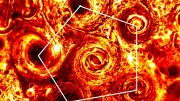
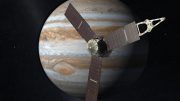
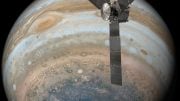

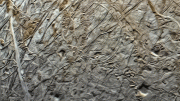
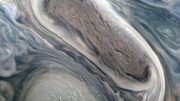
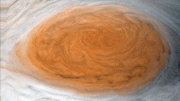
Be the first to comment on "NASA’s Juno Spacecraft Makes Its Fourth Flyby Over Jupiter’s Mysterious Cloud Tops"